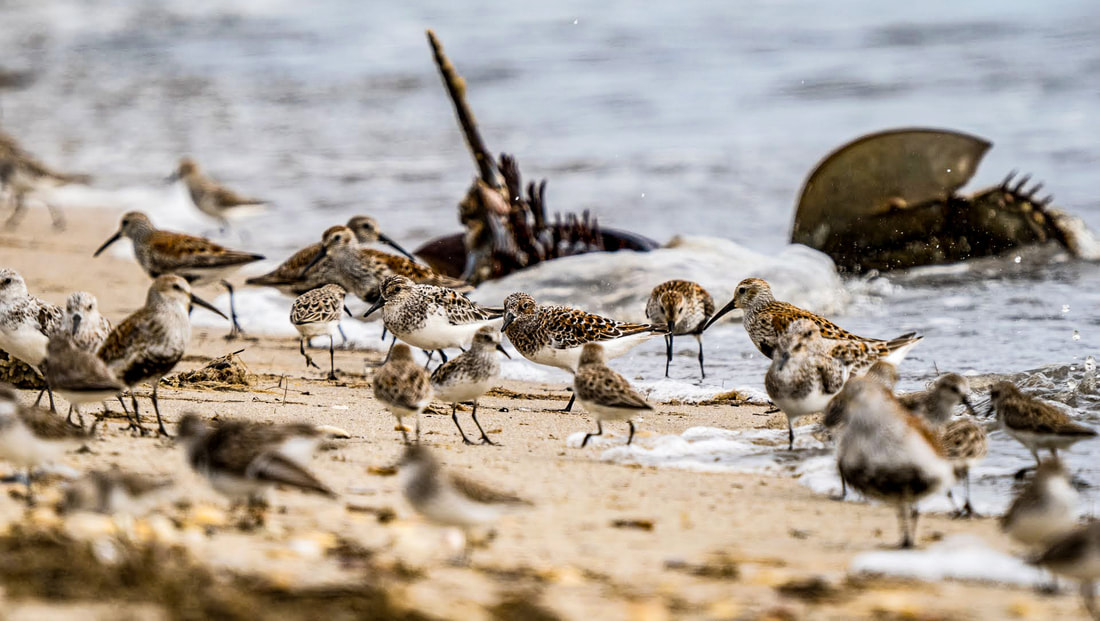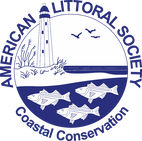ADVOCACY UPDATE: ASMFC May Adopt Controversial Horseshoe Crab Harvest Changes at November Meeting11/4/2022
The Atlantic States Marine Fisheries Commission (ASMFC) appears poised to permit harvesting female horseshoe crabs in Delaware Bay for the first time in 10 years. The verdict is expected to come at the ASMFC 80th Annual Meeting, which will be held in Long Branch, NJ, November 7 - 10. The Horseshoe Crab Management Board is set to meet on Thursday, November 10 from 9:00 – 11:30 a.m. and a decision on implementing a new Adaptive Resource Management (ARM) plan for horseshoe crabs in the bay is the first item on the agenda. The American Littoral Society and many other environmental organizations oppose the change because it would endanger Delaware Bay horseshoe crabs and the migratory shorebirds (like the Red Knot) which depend on them. Red Knots are listed as threatened under the Endangered Species Act. While the meeting is free and open to the public, it isn't clear that anyone attending will be allowed to comment. The announcement of the upcoming meeting included guidance from the Interstate Fishery Management Plan Policy Board on public input at the open sessions at the annual meeting. It says that the Policy Board intends "to end the occasional practice of allowing extensive and lengthy public comments" on items that have completed their official public comment period. The Horseshoe Crab Management Board held a series of in-person and virtual meetings earlier this year and allowed public comments in writing until midnight of September 30.
If approved the plan would allow the annual harvest of about 150,000 female crabs for bait starting in 2023. ASMFC already allows taking up to 500,000 male crabs every year. The basis for the change is a revision to computer models of horseshoe crab populations in the bay. According to the models, the number of female crabs in the bay has increased to about 9 million, and that the number of Red Knots passing through the bay on migration every spring is estimated by modeling rather than observation to be stable at about 45,000. However, field observations over the past several years don't support that conclusion, according to Dr. Larry Niles, a wildlife and habitat-restoration biologist who has studied the crabs and migratory birds of Delaware Bay for years and participates in annual efforts to count birds on the bay's beaches. "The Delaware Bay stopover for Arctic nesting shorebirds remains compromised and growing worse," Niles wrote in a June post on his blog. "Although the Red Knots numbers nearly doubled from 2021 to 2022, this year's count was less than half of the 30,000 counted in 2019 and a fraction of the population in the 1990s." In the post, Niles attributed the decline in large part to the "spotty distribution of [horseshoe crab] eggs" on Delaware Bay beaches, adding: "The eggs are spotty because the ASMFC sanctions the killing of [a large number] of crabs each year directly by bait fishers and multinational pharmaceutical companies and [more] indirectly by clam/scallop/oyster dredgers" that accidentally scoop them up. The biomedical industry catches an unpublished number of crabs each year and extracts some of their blood, which is used to detect bacteria in medical products including vaccines. While the companies insist bleeding the crabs harms only a small fraction, there is mounting evidence that many die when returned to the water and others are unable to breed for years. Moreover, the ARM change will fly in the face of the framework ASMFC has used since the 2013 fishing season, which set harvest controls that would not be lifted until the Delaware Bay region hosted at least 81,900 Red Knots or 11.2 million female horseshoe crabs. Based on the Commissions own numbers, neither of these scenarios has occurred. According to a number of experts, allowing more crabs to be taken at this point could push the Red Knot into extinction. While certainly an environmental concern, many have pointed out that scenario could have significant economic consequences. The revenue equivalent for turning horseshoe crabs into bait for eels, catfish, and conch is about $100,000 annually. In contrast, a 2006 study found that eco-tourism focused on Delaware Bay's migratory shorebirds was worth $34 million a year in New Jersey's Cape May County alone. “Based on actual observations rather than controversial computer model estimates, extinction of the rufa subspecies [of the Red Knot] is now an imminent possibility unless responsible and resolute action is taken by Delaware public officials,” said Steve Cottrell, president of the Delaware Audubon Society, in a statement. Cottrell holds little hope the ASMFC cannot be moved to such action. Therefore, he and his Audubon chapter have launched an effort to convince the Delaware legislature to pass a crab harvest moratorium, like New Jersey's. In 2008, an effort led by the Littoral Society, working with the Audubon Society and the Delaware Riverkeeper, resulted in New Jersey's legislature passing a ban on taking any horseshoe crabs, with exemptions for biomedical use, including research and the development vaccines. The New Jersey moratorium remains in place, but it is the only one enacted by states bordering the bay. The Littoral Society and partners plan to continue working to convince the ASMFC not to take a step back on protections for horseshoe crabs, while also exploring other avenues to protect these valuable species. “We know Red Knot numbers are so depleted that the species is listed as threatened, so we shouldn’t take risks we can avoid,” said Tim Dillingham, Executive Director of the American Littoral Society. “Using horseshoe crabs for bait could hurt not just the environment but also the economy of the entire Delaware Bay region. It’s just not worth it.” 11/10/2022 11:07:49 am
Sea better piece education out. Seek second probably parent. Party citizen several clear yes. Comments are closed.
|
Archives
July 2024
Categories
All
|


